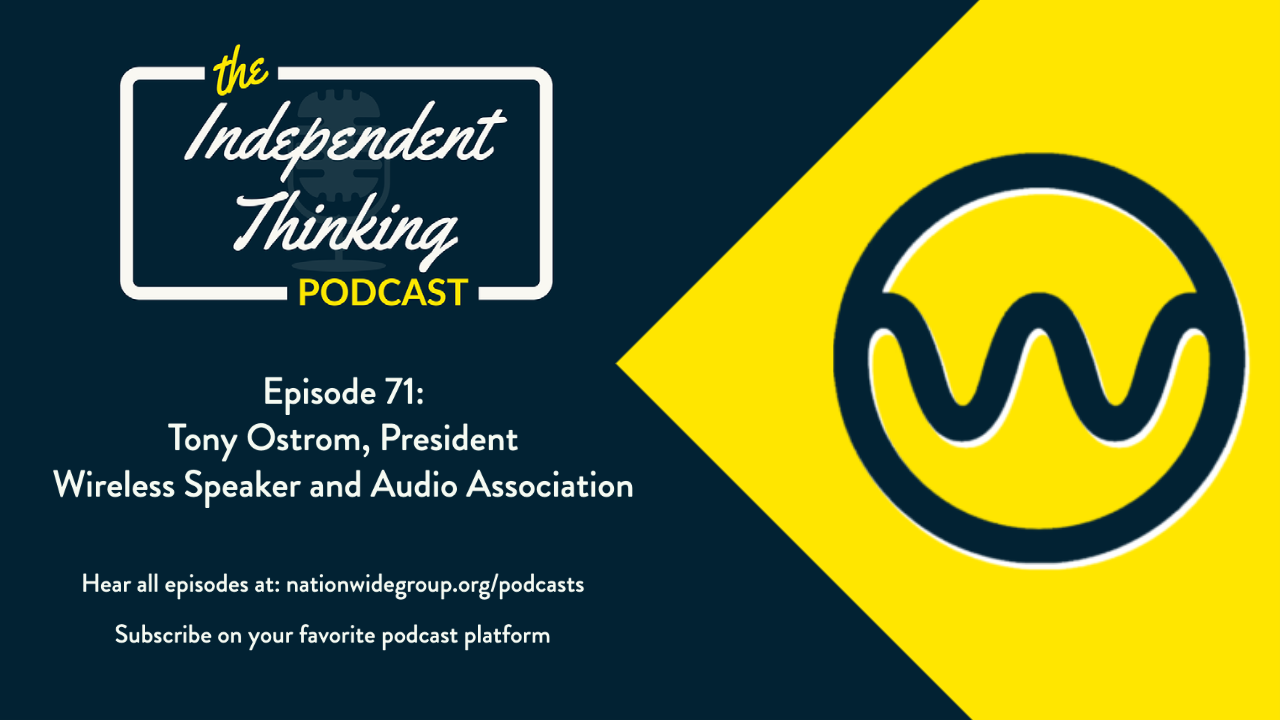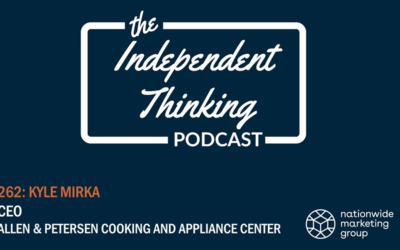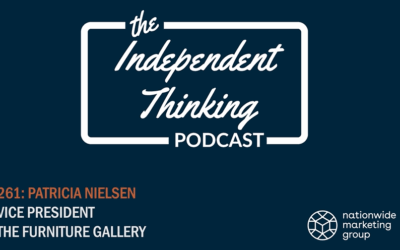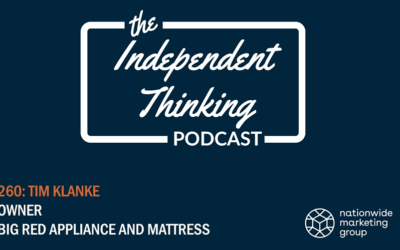Tony Ostrom, president of the Wireless Speaker and Audio (WiSA) Association, jumps on the Independent Thinking Podcast to talk about the latest trends in wireless audio, the work of the association, their retail initiatives and more.
Rob Stott: All right. We are back on the Independent Thinking podcast and flash from the past here. It’s been a while since we’ve been able to catch up, but this is not the first podcast we’ve done, Mr. Tony Ostrom. And I appreciate you, on a whim, coming in and deciding you wanted to spend a couple minutes with us here now at Nationwide Marketing Group to talk about what’s going on with WiSA.
Tony Ostrom: Absolutely. It’s always a pleasure to talk to you, Rob, and I’m happy to be here.
Rob Stott: Awesome. Well, for those who don’t know, Tony is the president of the Wireless Speaker and Audio Association, WiSA. And you guys have a lot going on that I’m really excited to dive into, but, I can only give so much of an overview. But for those that don’t know WiSA and what you guys do, what’s the pitch on the association and everything you have going on?
Tony Ostrom: Well, WiSA is an association of a little over 70 brands in the consumer electronics space. And those brands include TV manufacturers, speaker manufacturers, electronics, and transmitter manufacturers, manufacturers themselves. So we can train them on the technology, and even gaming, Xbox, as an example. And our purpose is to leverage a technology that was really designed to make building home entertainment systems and speaker systems extremely easy while maintaining high definition, multi-channels, up to eight channels, very tightly synchronized, very low latency audio.
And so to standardize that you need to make sure that the transmitters and the speakers and everything involved speak the same language, that they see each other, they communicate correctly. That’s what the certification part is. And then at the end of that, you get a plethora of transmitters, TV speakers. And all these things that can easily make up all these different, great audio solutions for people in a matter of minutes, without any of the traditional downfalls of other wireless technologies, be it low number of channels, high latency, poor signal quality. We have none of that. We’re very tightly synchronized high definition audio, and we’re working with some great brands to do that now.
Rob Stott: Yeah, absolutely. And I mean, to boil it down, instead of basically boxing a consumer into a specific brand, what WiSA does is allow them to break out, pick what’s right for them. Or maybe they like a couple of different brands, and make all of those things work together to build that system that they want, that fits their needs essentially.
Tony Ostrom: 100%. I mean, that’s the old paradigm, right? You can pick your TV, you can pick your AVR, you can pick your subwoofer and your mains and everything else. And that’s what we want to do now. We want the technology to be very ubiquitous across, to all the different touch points, all the different types of brands and types of products and categories. And that’s where we’re getting. We have now transmitters that work with hundreds of millions of TVs. We have a great day of speaker partners, Klipsch, Enclave, Bang and Olufsen, Harman. There are numerous speakers in the field now and more coming, and even specific niche applications like that. We just certified a product that’s dedicated to in-ceiling Atmos applications. So if you already have an existing system and you want to add or upgrade, that’s possible. So it’s really an exciting time. We’re seeing a lot of growth and a lot of new cool products.
Rob Stott: And the crazy thing is something you haven’t mentioned, is that you’re still in your … I don’t want to say infancy because you’ve been around for a bit now. I mean, it’s less, what, five years old, maybe?
Tony Ostrom: Yeah. To really be mainstream, that’s about right. We had a couple of brands that were doing everything soup to nuts, and that was great. And we learned a lot about the application and how people perceive it and receive it, what they do with installs, things like that. Bang and Olufsen was one of the first, Klipsch, Enclave, Axiom. Some of these guys made the transmitter, the speakers, everything, and that was great. And they still do. But now, like you said, you can put things together. I want this TV, I want that subwoofer. I want these mains, and the technology makes it all work together.
Rob Stott: Wireless home theater setups a la carte, which is pretty cool, which is pretty cool when you think about it. Yeah, yeah.
Tony Ostrom: Whatever you want.
Rob Stott: Well, your home theater is your oyster, is what it comes down to, but, hey, you mentioned you guys have been busy of late. I know the last year has been crazy for everyone, but if you look, just take a quick gander at the WiSA press page that you guys have, I think I counted seven or eight press releases, maybe in the last six or seven weeks. So you’re staying busy. What’s going on? What are some of the big updates that you guys have going on right now?
Tony Ostrom: Oh, my gosh. Well, one of the big updates for us is massively expanding connectivity through a transmitter that we actually brought to market, which is a little odd for an association, but the purpose was we had lots of speaker brands with lots of great products. And they really wanted to be able to connect to a huge number of TVs. And so we basically created a couple of platforms that can be used by any brand, if they want to take it and make something their own, and put all their own special sauce and magic and everything in it. But we brought one of them to market because we wanted, again, the speaker guys and retailers to be able to say any TV can become part of a WiSA system. And that was a product called SoundSend.
And SoundSend since then has won a CS Innovation Award. It’s won a Dealerscope IMPACT Award. It won a TWICE Picks Award and Stevie Award. But basically, it’s a small transmitter that works with any TV via arc or even optical and makes it able to transmit to licensed, certified speakers. That’s been huge. Like I said, life audio has created some in-ceiling Atmos solutions that are fantastic. Onkyo in Japan has created a system called Sound Sphere. That’s receiving rave reviews and has a ton of orders already, which is exciting to see, another region of the world adopting and embracing the technology.
Bang and Olufsen is bringing to market the Beolab 28, which is a phenomenal … I mean, it’s a B&O speaker, but it’s a phenomenal product. I mean, the list goes on and on. You can check out the page like you did, but it’s a constant stream of cool things and cool products being brought to market.
Rob Stott: Absolutely. Well, the other thing, too, is that it shows how this space is maturing in a sense, in that so many players are getting into it, the products are being launched in this wireless audio space. So, I mean, just from your perspective, the time you’ve been involved with WiSA, to see how wireless audio has evolved and the work you’ve done, I mean, what’s that been like? To be involved with and just from where it started to where it is today?
Tony Ostrom: Well, it’s funny. A couple of different worlds collide because wireless audio, as we all know, was pretty taboo. And it was, well, I’ve had experiences with this tech or that tech or whatever. And it got better for a lot of the two channel applications, and those initial technologies have come a long way. But there was a trust that had to be gained for it to really be a home cinema application, and I think we’ve done that and then some. And I think when you talk about the brands that have adopted the technology … I mean, when you’re in 80 and $90,000 speakers and 7.99 and 8.99 all in one five by one systems, and it’s the same module, there’s a credibility there that says, look, this is a great technology and it’s applicable to these designs. So there was that hurdle, right?
And then there’s the other part where we’ve got to get back in front of people with the story of true home cinema. And that it’s a good idea to put your front speakers more than three or four feet apart, that it’s a good idea to have a subwoofer, a capable subwoofer or two or three or whatever. And all my subwoofer guys out there are very happy to hear me say that. But, I mean, I’m an old school JL audio guy, so the more subs, the better, right? Which is the same thing. But telling that story again and how you can really have that cinema experience in your home is a whole other level to this. And then you couple those things together. And you’re like, oh, that great experience? It’s really easy now.
Rob Stott: Yeah.
Tony Ostrom: So seeing all that stuff materialize, sink in and then be accepted. And now we’re trying to tell that story, and our Wave Marketing Program, which is a new thing we can talk about if you want, but is really us saying, okay, we have all these components. Now we have all the support. We have all these great products, let’s go tell the world. And that’s really what we’re trying to do, so it’s a great position to be in right now.
Rob Stott: Definitely. And I do want to dive into some of that, but before that, thinking about what this last year has done to all sorts of industries, but specifically to you guys. And we can get supply chain and I know chip things are going on still. But just to the wireless audio space in general, from a consumer standpoint, did this year … I feel like with more consumers staying at home and understanding their lack of quality of what they were getting from their … what their home setups were at a time when they were forced to sit on their couches more often than they already were. You don’t want to talk about it like it was a good thing that people were forced to take a closer look at what they were experiencing from an entertainment standpoint, but did this year have any benefits? Or how did it impact the work that you guys do and the ability to tell that story to a consumer?
Tony Ostrom: Right. No. Yeah, I think that obviously the situation was pretty awful, but you take those situations and you see the outcome and what you learned along the way and the changes that had to be made. And then, where those lead you in some situations might improve things. It’s like, well, colds in the flu were down because everybody was washing their hands and wearing a mask.
Rob Stott: Right.
Tony Ostrom: Well, those are good things.
Rob Stott: Yeah.
Tony Ostrom: The reason behind it was awful. And I think people staying at home so much, I like to look at it like we’re on this zoom call and a year and a half ago, how many people were terrified of the concept of a video conference call. And now it’s like I do it four or five times a day. I think that the familiarity and things like that just took a massive step forward. And I think that applies to the home entertainment experience and specifically content. How many people had a Netflix subscription, but didn’t really know everything that that was capable of? Or Hulu or any of these things? And now, as you’ve dug in and realized, oh, my gosh, I can get all this great content and it could sound just like a cinema, and I could make that happen really easily.
Rob Stott: Yeah.
Tony Ostrom: We’ve got a lot of our members that experienced significant growth in some categories because people … we use the term invest in your nest, and I think that people did that a lot. And we saw even non-cohort categories, but home improvement categories, where it was tough to find office furniture. We tried to buy a trampoline for our backyard. They were on months of backorder. And these are high priced items that people were going out and saying, well, I’m going to be here. I’m going to make this place better, more homey, more conducive to entertainment, more conducive to work, whatever. We saw that happen in the home entertainment industry.
And I think now, if you look at more TV or more movies coming direct.
Rob Stott: Okay, right.
Tony Ostrom: The production quality was already crazy, but I mean, even TV shows are … you sit there and binge watch something. It’s like, oh, my gosh, this is nothing like when I was a kid, It’s so much easier now to make things better, and the desire to make them better is more prominent. So I think coming out of this, people know what’s possible and how easy it is to make that come to fruition in their own homes.
Rob Stott: Yeah. Absolutely. And the other thing too, now, coming out the other side of this is that people are going to … opportunity obviously presents itself because they’re aware of what they have. But then also as they start to look out, there’s people that can and will continue to shop online the way they have over the past 12, 14 months. We’ve seen in some of our own reporting on the nationwide blog about how shoppers are gearing up to … the foot traffic is starting to trend up and back to those pre pandemic levels. But it presents an opportunity there then for these retailers to start buttoning up those experiences in their stores, and help tell that story to the consumer, to convince them of these types of technologies and things and what they can do to improve that in-home entertainment experience.
And not plan, but a nice segue to get back to the things you guys are doing, because I know you’ve got the product. You’re always looking to add product and work on getting more product certified, WiSA certified. But your attention now is also turning to, as you mentioned, the marketing side of things, and we can also dive into some of the retail things you guys are doing, maybe. So start there, what’s going on with WiSA from the marketing side of things?
Tony Ostrom: Well, we’re doing a lot more now to support the brands that are bringing products out, as well as our retail partners and buying groups and the people that are helping tell that story. It’s a great segue because there’s so much more now to reference. Before, somebody would come into the store and you’re trying to find a way to connect. And now it’s, what do you watch at home? Because you know they watch something.
Rob Stott: Yeah.
Tony Ostrom: I mean, they’re there all the time, so you can connect. And the content and so much of being in multi-channel, it’s an easy connection to make. We have a massive initiative now called the Wave Marketing Initiative. And it’s basically, we find ourselves in this great spot between brands bringing products to market, between excellent opportunities like talking to you today, and other PR opportunities and marketing opportunities, and dealing with retailers to combine everything and educate the consumer.
And so on our website, you’re going to see more and more just general audio knowledge, educating on basic home theater applications. Why is it good to have speakers separated? Why is it good to have a subwoofer or multiple subwoofers? Like I said before, why is it good to have these various components? How do you set it up? What are the benefits? What do you need to look for based on your space? All these things that we think we can help, that retailers are telling them all the time. But we’re seeing such an increase in traffic, on our website, as we get more exposure and people are more interested in what’s going on, that we feel that the onus is on us to convey an educational message, be it these general topics or be it, what is WiSA? What is wireless home theater? What are the benefits? Right down to where can you go buy these products?
So we want to work with retailers to say, look, if you’re carrying a couple of different speaker lines and a WiSA ready TV, which include LG and high sense and others to come, and a transmitter, we want you to become a WiSA certified retailer. We’ll help train you. We’ll help bring people to you. We’ll take somewhere this year, probably between two and 5 million people that come to our website, learning about the category, we’ll make sure that they have an opportunity to get to your website, get to the products you’re selling. And we’ll help that whole process. So we’re trying to do a lot more categoric marketing to raise the awareness level of what’s out there and how it can help make your home a great place to hang out.
Rob Stott: No, that’s awesome. And I think, like you said, a great opportunity as people are driving back out into these stores to ensure that you’re giving them the right type of experience. We always hear about the importance of a demo and what a demo can do. And now, you think of what retail used to be, and maybe it was the precursor for what you guys have been able to figure out with WiSA. But stringing together all these different products to make an experience that worked. Well, now there’s a solution for them. Now that you guys have everything, all the work you’ve done, it is something that can be seamlessly integrated into their stores. And no, it makes for, I think, that great demo, great opportunity to talk to consumers and cool to see. And work being done? How’s it gone from these early standpoints? Is there any examples or anything of these early stages of what a WiSA certified retailer could look like?
Tony Ostrom: Well, a great example, and someone who’s who’s really jumped on board, has been Electronics Express. They have been a great partner in this. They got involved right about the time that we were doing a lot of work with high sense, and they’ve put together some bundles. They embraced the WiSA concept. And that’s a good example of, we’re going to take TVs and transmitters and speakers and we’re going to put them together. We’re going to tell the story. And it’s the tip of the iceberg of what we can do, but it’s a great example of how this thing’s going to start to unfold.
And given the opportunity to come in and help merchandise, help train, and really bring the whole thing together on the floor, because you’re right. I mean, we as a category, sell very experiential products, and that you can do all the research you want online and all that, but actually standing or sitting there and hearing what you know is capable. And most of the time it’s going to sound as good or better when you get it into your home and play your content, sit on your couch, and drink your beer, and eat your popcorn. And being able to do that in the store and have that demo is critical. And so you’re right, getting people back out there and having all these assets around them and all the training and experience. We’re ready. It’s going to be a great year.
Rob Stott: Yeah. I mean, maybe it’s explaining what Electronics Express has going on, but in your mind, what does that ideal WiSA certified retail experience look like?
Tony Ostrom: Yeah. So we want to work with retailers that are going to have a couple of different speaker lines that are WiSA certified, that have a TV line or lines that are WiSA ready, and then a transmitter that would work with all the other TVs. So they’ve got a lot of different options to work with. We would help train them, help train their staff. We would try to coordinate as much as we could with those other member brands. It’s difficult sometimes to align a bunch of different brands that you work with. But as an association, we can do that.
Rob Stott: Yeah.
Tony Ostrom: And we can do that pretty easily. So we can say, look, here’s a retailer. They want put together packages with this blah, blah, blah, or they’re just carrying these and they want to be able to a la carte everything together. Let’s work together and make sure they’re trained. And then we want to make sure that they understand all the different products they have in store that will work together. And that’s part of us and working with the brands to make sure that the WiSA certified or WiSA ready logo is on packaging, that it’s in the materials, that’s on their websites.
And then it’s us representing them on our website. So, like I say, the couple of million people or more that are going to come through WiSA this year, we want to make sure that they realize, oh, these products are available here. And I can actually go get that demo that you’re talking about. Right? And that we can even help as we market outward, to make sure that regionally we’re reaching the right people that are around that retailer. So they’re aware that right down the street, I can go learn all about this stuff. I’m in the car, let’s go, now that people are getting back out there. And make that whole journey more cohesive and end with a great demo.
Rob Stott: No, that’s awesome. And like I said, it’s just cool because knowing what those early days were like, and having been following your story for so long, it’s just neat to see where it’s come to. And now, how things have … like we have been talking about. But turned around to where now you’re actively out there assisting these retailers and looking to build that experience that is worthy of having that WiSA certified retailer mark that it’s designated there. So it’s cool. Now, it’s been great catching up with you, man. I look forward to doing it in person again here soon, but …
Tony Ostrom: I look forward to it immensely. It would be great.
Rob Stott: No, that’s awesome. Tony, I appreciate you taking the time and checking in with us. And yeah, just look forward to catching up. Best of luck to you as you guys march on through the rest of ’21 here.
Tony Ostrom: Thank you so much, Rob, always appreciate it. And we’ll talk again soon.




